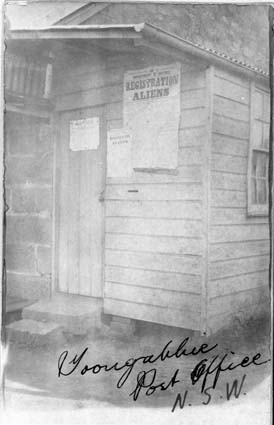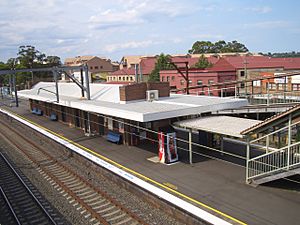Toongabbie facts for kids
Quick facts for kids ToongabbieSydney, New South Wales |
|||||||||||||||
|---|---|---|---|---|---|---|---|---|---|---|---|---|---|---|---|

Portico Park
|
|||||||||||||||
| Population | 16,177 (2021 census) | ||||||||||||||
| • Density | 689.76/km2 (1,786.5/sq mi) | ||||||||||||||
| Established | 1792 | ||||||||||||||
| Postcode(s) | 2146 | ||||||||||||||
| Elevation | 33 m (108 ft) | ||||||||||||||
| Area | 23.453 km2 (9.1 sq mi) | ||||||||||||||
| Location |
|
||||||||||||||
| LGA(s) |
|
||||||||||||||
| Region | Greater Western Sydney | ||||||||||||||
| State electorate(s) |
|
||||||||||||||
| Federal Division(s) | |||||||||||||||
|
|||||||||||||||
Toongabbie is a suburb in Sydney, New South Wales, Australia. It's about 30 kilometres west of the main city centre. Toongabbie is one of Sydney's oldest suburbs and is part of the wider Greater Western Sydney area. It's managed by three different local councils: the City of Parramatta, the City of Blacktown, and Cumberland Council. People sometimes call it "Toonie" for short!
Contents
Where is Toongabbie?
Toongabbie is surrounded by other suburbs. To the north, across Old Windsor Road, is Winston Hills. To the east, you'll find Old Toongabbie. If you go south-east, you'll reach Pendle Hill. To the south is Girraween, and to the south-west is Prospect. Finally, to the west is Seven Hills.
Toongabbie's History
The original owners of the land where Toongabbie now stands are the Dharug peoples. These Aboriginal groups often lived near rivers and streams. The area used to have lots of plants and animals in its bushland and waterways.
The name Toongabbie comes from an Aboriginal word. It means "place by the water" or "the meeting of the waters." Governor Arthur Phillip gave the area this name in June 1792. He asked the local Aboriginal people what they called the place.
Early European Settlement
Toongabbie was the third place on the Australian mainland where Europeans settled. This happened after Sydney and Parramatta were set up in 1788. However, the exact spot of this first settlement is actually in the separate suburb of Old Toongabbie.
In 1791, Governor Phillip started a government farm and a convict station here. It was on 640 acres (259 hectares) of land. The goal was to grow food for the new colony. By December 1791, 500 men were working to clear the land.
After eleven years, the government farm closed. The land was then given to settlers and convicts who had finished their sentences. In March 1797, a big fight called the Battle of Parramatta happened here. Aboriginal resistance leader Pemulwuy led about 100 Bidjigal warriors. They attacked the government farm, challenging the colonists.
Growing Toongabbie
In 1860, the railway line reached Blacktown. But it took 20 more years for trains to start stopping at Toongabbie. The first school, Toongabbie Public School, opened on May 3, 1886. It closed in April 1911 because not enough students were enrolled. But it reopened in February the next year and has been open ever since.
The first post office opened in 1887 after locals asked for it for many years. It was in a private house on Old Windsor Road until the 1960s. The first postmaster, Mr. Birks, was paid 25 pounds a year. He managed the office and brought mail from Seven Hills on horseback daily.
By 1922, there were enough people and businesses for a second post office. It was in a cottage in Wentworth Avenue and called Toongabbie West. In 1960, a new, purpose-built office opened in Portico Parade. This became the main Toongabbie Post Office, and the old one was renamed Old Toongabbie.
A private railway line opened in 1902. It ran from Toongabbie to Prospect Quarry. Trains stopped running on this line in 1945 because the government railway couldn't provide enough wagons. However, the tracks stayed until the early 1960s.
In 1908, one of Australia's first scout groups, 1st Toongabbie Scout Group, was started by Errol Knox. Their first scout hall was a barn on his parents' property. In 1934, the group moved to its current spot on Bungaree Road.
The first bank branch, the Commonwealth Bank, opened in Toongabbie in 1957. Before that, smaller bank services were available. Toongabbie got electricity in the mid-1920s. Town gas and main sewerage connections arrived in the mid-1960s.
The biggest increase in people living here happened after World War II. A large area west of the shops, which used to be farms, was turned into a housing area. It was called "The Old Roman Estate." Many streets there have Roman names, like Marcia St and Portico Parade.
Since the 1990s, many older houses have been replaced by apartment buildings. This is especially true around the main shopping area.
Old Toongabbie Area
To the east of Binalong Road and Reynolds Street is the small suburb of Old Toongabbie. This area includes the sites of the first colonial settlement. In the 1990s, part of this area was reclassified as Wentworthville. In 2006, Constitution Hill officially returned as a small area.
Winston Hills Area
The northern parts of Toongabbie, north of Toongabbie Creek, became known as Winston Hills in the late 1960s. At first, this was just the name of a large housing development. But later, a big part of what was once Old Toongabbie was officially renamed Winston Hills.
Shopping and Businesses
Toongabbie's main shopping area is on Aurelia Street. It's south of the railway line and right next to the station. For many years, there was a small cinema called the "Rocket Theatre" here. It operated from the late 1950s to the early 1970s. It was then pulled down and replaced by shops.
A small park called Portico Plaza is directly opposite the train station. The Piccadilly Centre, a shopping centre with a supermarket, was built in the 1960s. In 2004, this centre was bought by a developer. They built Portico Plaza, a new shopping centre with a Woolworths supermarket and over 40 other shops. Since the 2010s, many shops and takeaways serving South Asian residents have opened in Toongabbie.
Getting Around Toongabbie
Toongabbie railway station is on the T1 Western Line of the Sydney Trains network. The first station opened on April 26, 1880, and was improved over the years. The current station opened in 1946, and the train line became electric in 1955. An overhead road bridge opened in 1947. Before that, there was a level crossing where the western end of the station platforms are now. The train station was updated in the late 2010s to include elevators.
Toongabbie also has private buses. You can catch buses to Blacktown via Blacktown Road, Seven Hills via the Prospect Highway, and both Parramatta and Westmead via the Great Western Highway. Toongabbie is also served by the North-West T-way, which is a special bus route.
Local Landmarks
Even though Toongabbie is quite built-up, there have been efforts to improve its natural areas. Programs have worked to restore bushland and control pollution in local waterways. The main waterway is Greystanes or Girraween Creek. It flows through the suburb from Fox Hills Golf Course in the south to join Blacktown Creek in the north. Part of Greystanes Creek has been changed to help prevent floods. This creek often floods a lot during rainy days, sometimes overflowing onto Station Road.
Parks and Recreation
Toongabbie has several parks and places for fun. Fox Hill Golf Club is on the western side of the suburb. McCoy Park is in eastern Toongabbie, near the border with Seven Hills. It has toilets, a large field, and a playground, and is located by the creek. Toongabbie Sports Club is on Station Road and has a bowling club.
Who Lives in Toongabbie?
| Historical population | ||
|---|---|---|
| Year | Pop. | ±% |
| 2001 | 12,800 | — |
| 2006 | 12,343 | −3.6% |
| 2011 | 13,003 | +5.3% |
| 2016 | 14,337 | +10.3% |
| 2021 | 16,177 | +12.8% |
According to the 2021 census, 16,177 people lived in Toongabbie. The average age was 35 years old. Children aged 0–14 years made up 20.2% of the population. People aged 65 years and over made up 12.8%.
About 43.8% of people were born in Australia. The next most common countries of birth were India (20.5%), Sri Lanka (6.0%), Philippines (2.7%), China (2.7%), and Nepal (2.1%).
Famous People from Toongabbie
- Bruce Beresford – a film director, writer, and producer who grew up here.
- Ebanie Bridges – a boxer who grew up here.
- Karl Filiga – a former professional rugby league player.
- David Klemmer – a current Rugby league player.
- John Larkin – an author who won a big literature prize in 2012.
- Lawrence Thomas – a football (soccer) player.
Schools in Toongabbie
Toongabbie has several schools for students. These include Toongabbie Public School, Toongabbie West Public School, Toongabbie Christian College, and Metella Road Public School. There are also many preschools for younger children.



